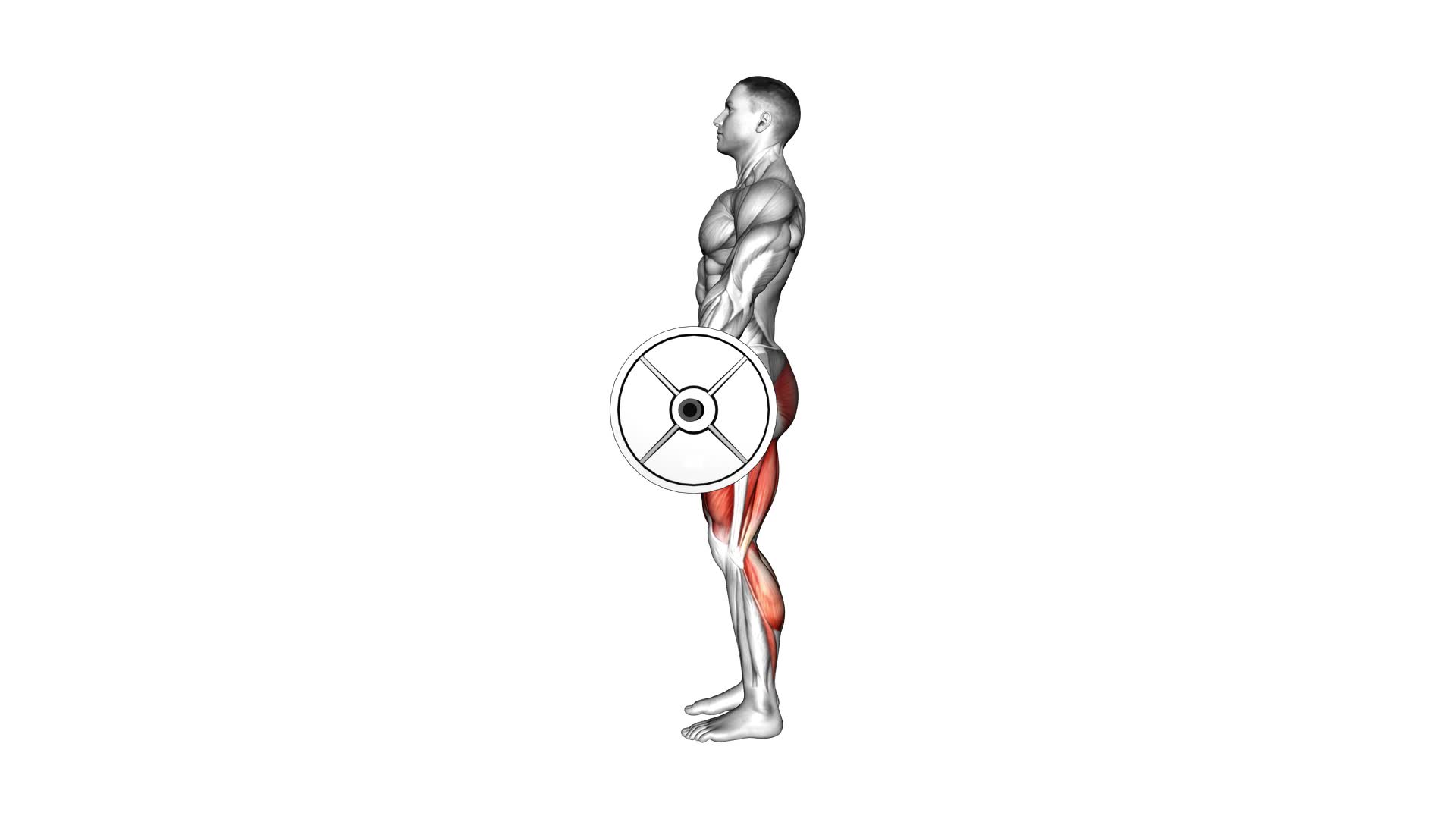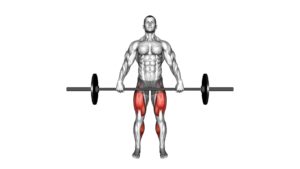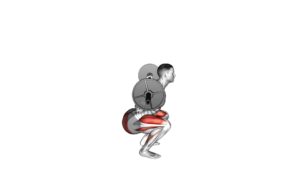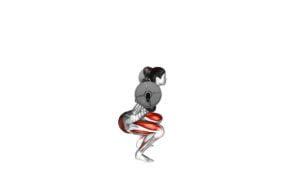Barbell Deadlift (side POV) (male) – Video Exercise Guide & Tips

Ready to take your workout to the next level?
Watch This Exercise Video
In this video exercise guide, we'll show you the proper technique for the barbell deadlift. With its numerous benefits, including increased strength and muscle development, this exercise is a must-have in your routine.
Avoid common mistakes and maximize your results with our helpful tips.
Get ready to challenge yourself and achieve your fitness goals with the barbell deadlift. Let's get started!
Key Takeaways
- Barbell deadlift improves overall strength.
- Barbell deadlift engages multiple muscle groups.
- Barbell deadlift builds functional strength.
- Barbell deadlift promotes muscle development and definition.
Benefits of the Barbell Deadlift
Improve your strength and muscle development with the barbell deadlift. This exercise is a powerhouse for improving strength and engaging multiple muscle groups. When performing the barbell deadlift, you're targeting your glutes, hamstrings, quadriceps, lower back, and core. It's a compound movement that requires you to lift a heavy barbell from the ground, working your entire body in the process.
By incorporating the barbell deadlift into your workout routine, you'll see significant improvements in your overall strength. This exercise not only builds raw strength but also improves functional strength, making everyday tasks easier. The barbell deadlift engages your muscles in a way that mimics real-life movements, making it a highly effective exercise for building practical strength.
In addition to strength gains, the barbell deadlift also promotes muscle engagement. The movement recruits a large number of muscle fibers, leading to increased muscle development and definition. Your glutes and hamstrings will become stronger and more toned, while your lower back and core muscles will become more stable.
Now that you understand the benefits of the barbell deadlift, let's move on to the next section: setting up for the barbell deadlift.
Setting up for the Barbell Deadlift
Now that you know the benefits of the barbell deadlift, how do you properly set up for this exercise? Follow these steps to ensure a safe and effective setup:
- Position the barbell: Place the barbell on the floor in front of you, ensuring it's centered and aligned with your midfoot. Use a weight that challenges you but allows for proper form.
- Stance and grip: Stand with your feet hip-width apart, toes pointing slightly outward. Bend your knees and hinge at the hips to grip the barbell with an overhand grip, hands slightly wider than shoulder-width apart.
- Set your back: Engage your core and straighten your spine, maintaining a neutral position. Avoid rounding or hyperextending your back, as this can lead to injury.
- Brace and lift: Take a deep breath and brace your core. Drive through your heels, extending your hips and knees simultaneously to lift the barbell off the floor. Keep the barbell close to your body throughout the movement.
By following these steps, you can prevent common mistakes and reduce the risk of injury during the setup phase of the barbell deadlift.
Now let's dive into the proper technique for performing this exercise.
Proper Technique for the Barbell Deadlift
To perform the barbell deadlift with proper technique, you need to focus on three key points.
First, maintaining a strong and neutral back position is crucial to prevent injury and maximize power.
Second, experimenting with different grip and stance variations can help you find the most comfortable and efficient setup for your body.
Back Position Importance
Maintain a neutral spine for optimal technique and safety during the barbell deadlift. The position of your back is crucial in ensuring proper form and preventing injury. Here are four key points to remember:
- Core Strength: A strong core is essential for maintaining stability and protecting your spine during the lift. Engage your abdominal muscles and lower back to provide a solid foundation.
- Proper Breathing Technique: Breathing correctly helps stabilize your core and maintain proper spinal alignment. Take a deep breath before lifting, hold it during the exertion, and exhale at the top of the movement.
- Neutral Spine: Avoid rounding or arching your back during the deadlift. Keep your spine in a neutral position by maintaining a slight inward curve in your lower back.
- Shoulder Blade Position: Retract your shoulder blades to stabilize your upper back and maintain proper alignment. This will help prevent excessive stress on your lower back.
By focusing on maintaining a neutral spine and following these guidelines, you can perform the barbell deadlift with proper technique and reduce the risk of injury.
Stay safe and keep challenging yourself!
Grip and Stance Variations
To perform the barbell deadlift with proper technique, it's important to consider grip and stance variations.
The grip technique you choose can greatly impact your ability to lift heavy weights and maintain control throughout the movement. One common grip is the double overhand grip, where both palms face towards you and grip the barbell. This grip is good for beginners or those who want to focus on building grip strength.
Another option is the mixed grip, where one hand faces towards you and the other hand faces away. This grip provides more stability and can help prevent the barbell from rolling out of your hands.
When it comes to foot positioning, you have a few options. The conventional stance involves placing your feet hip-width apart, with your toes pointing forward. This stance allows for a balanced and stable base.
The sumo stance, on the other hand, involves placing your feet wider than hip-width, with your toes pointing outwards. This stance can help target different muscle groups and may be beneficial for individuals with limited hip mobility.
Experiment with different grip techniques and foot positioning to find what works best for you and your deadlift goals.
Common Form Mistakes
Avoid these common form mistakes to ensure proper technique for the barbell deadlift. By improving your form and preventing injuries, you'll be able to maximize the benefits of this exercise.
Here are four common form mistakes to watch out for:
- Rounded back: Keep your back straight throughout the entire movement. Engage your core and maintain a neutral spine to protect your lower back.
- Leaning too far forward: Maintain a balanced position by keeping your weight centered over your midfoot. Avoid leaning too far forward, as it can put excessive stress on your lower back.
- Jerking the weight: Lift the barbell smoothly and avoid any sudden movements or jerks. This will help you maintain control and reduce the risk of injury.
- Neglecting hip hinge: Remember to initiate the movement by hinging at your hips, rather than relying solely on your lower back. This will engage your glutes and hamstrings, improving your overall form.
Common Mistakes to Avoid
When performing the barbell deadlift, it's crucial that you focus on proper form and technique to avoid potential injuries. One common mistake to avoid is rounding your back during the lift. This puts excessive stress on your spine and can lead to serious back injuries. To maintain proper form, engage your core, keep your chest up, and maintain a neutral spine throughout the movement.
Another mistake to avoid is lifting with your arms instead of your legs and hips. Remember, the barbell deadlift is a lower body exercise, so the power should come from your legs and hips, not your arms. Make sure to push through your heels, engage your glutes and hamstrings, and drive the barbell upward using the strength of your lower body.
Lastly, avoid jerking the barbell off the ground or using momentum to complete the lift. This not only compromises your form but also increases the risk of injury. Instead, focus on a controlled and smooth movement, maintaining tension in your muscles throughout the entire lift.
Tips for Maximizing Results
To maximize your results with the barbell deadlift, focus on proper technique and incorporate progressive overload into your training. Here are some tips to help you maximize gains and make the most out of your workouts:
- Start with light weights: It's important to master the correct form before adding heavy weights. Begin with lighter loads and gradually increase the weight as your technique improves.
- Engage your core: A strong core is essential for maintaining stability and generating power during the deadlift. Make sure to brace your core and keep it tight throughout the movement.
- Vary your grip: Experiment with different grip variations, such as overhand, mixed, or hook grip, to find what feels most comfortable and secure for you. This can help prevent grip fatigue and allow you to lift heavier weights.
- Modify your workout: Incorporate variations of the barbell deadlift, such as sumo deadlifts or Romanian deadlifts, to target different muscle groups and prevent plateaus. This will help maximize gains and keep your workouts challenging.
By following these tips and incorporating workout modifications, you can ensure that you're getting the most out of your barbell deadlifts.
Now, let's transition into the next section, where we'll discuss safety precautions and injury prevention to help you stay safe during your training.
Safety Precautions and Injury Prevention
To ensure your safety and prevent injuries while performing the barbell deadlift, focus on proper form and technique. By following these safety precautions and incorporating warm-up exercises into your routine, you can greatly reduce the risk of injury and maximize your results.
First and foremost, it's crucial to warm up properly before attempting the barbell deadlift. Engaging in dynamic stretches and light cardio exercises, such as jogging or jumping jacks, will increase blood flow to your muscles and prepare your body for the upcoming workout. This will help improve your range of motion and prevent muscle strains or pulls.
When performing the barbell deadlift, always start with a weight that you can handle comfortably. It's better to gradually increase the weight as you become more proficient and confident in your form. Using too much weight too soon can lead to poor technique and increase the risk of injury.
Additionally, maintaining proper form throughout the exercise is essential. Keep your back straight, shoulders back, and engage your core muscles. Avoid rounding your back or using your lower back to lift the weight. Remember to keep your feet shoulder-width apart and grip the bar with your hands slightly wider than shoulder-width.
Frequently Asked Questions
Can the Barbell Deadlift Help Improve My Posture?
The barbell deadlift can definitely improve your posture. By incorporating this exercise into your routine, you can improve flexibility and correct rounded shoulders.
The deadlift targets multiple muscle groups throughout your body, including your back, glutes, and core. Strengthening these areas can help you maintain proper alignment and improve your overall posture.
How Often Should I Incorporate Barbell Deadlifts Into My Workout Routine?
To get the most out of your workouts, it's important to incorporate barbell deadlifts into your routine.
The barbell deadlift is a great exercise that targets multiple muscle groups and can help improve your overall strength and posture. By performing the exercise with proper form and technique, you can maximize the benefits and avoid injury.
Additionally, don't forget to try out different variations of deadlifts to keep challenging your muscles and prevent boredom. Make sure to consult with a fitness professional to ensure you're performing the exercise correctly.
Can the Barbell Deadlift Help With Weight Loss?
The barbell deadlift is a great exercise to incorporate into your weight loss routine. It engages multiple muscle groups, helping you burn calories and build strength.
Before starting, make sure you learn the proper form for the barbell deadlift. As a beginner, start with lighter weights and gradually increase as you gain confidence and strength.
Remember to engage your core, keep your back straight, and lift with your legs.
Stay consistent and motivated, and you'll see results in no time.
Are There Any Alternative Exercises That Can Provide Similar Benefits to the Barbell Deadlift?
Looking for alternative exercises that provide similar benefits to the barbell deadlift? Well, you're in luck!
Goblet squats and Romanian deadlifts are two great options worth considering.
Goblet squats target your lower body, including your glutes and quads, while also engaging your core.
Romanian deadlifts focus on your hamstrings, glutes, and lower back, helping to improve your strength and stability.
Can the Barbell Deadlift Help Increase My Overall Strength and Power?
The barbell deadlift is an excellent exercise for increasing overall strength and power. By incorporating this exercise into your routine, you can target multiple muscle groups, including your legs, back, and core.
The barbell deadlift benefits extend beyond just strength gains, as it also improves your posture and grip strength.
To perform this exercise correctly, focus on maintaining proper form and technique, such as keeping your back straight and engaging your glutes and hamstrings.
Keep pushing yourself, and you'll see amazing results in no time.
Conclusion
Incorporating the barbell deadlift into your workout routine can bring numerous benefits. This exercise is known for increasing strength, improving posture, and enhancing muscle development. By following the proper setup and technique, you can maximize your results and avoid common mistakes that may lead to injury.
Remember to prioritize safety precautions and injury prevention when performing the barbell deadlift. This includes using proper form and technique, starting with lighter weights to build strength and gradually increasing the load. It's also essential to warm up properly and listen to your body to avoid overexertion or strain.
The barbell deadlift is a compound exercise that targets multiple muscle groups, including the hamstrings, glutes, lower back, and core. It's an excellent exercise for building overall strength and power. Additionally, the deadlift can improve your posture by strengthening the muscles that support your spine.
To perform a barbell deadlift correctly, start by standing with your feet hip-width apart and the barbell centered over your midfoot. Bend your knees and hinge at the hips to grip the bar just outside your legs. Keep your back straight and engage your core as you lift the barbell by extending your hips and knees. Pause at the top for a moment, then lower the barbell back to the ground in a controlled manner.
Keep pushing yourself and enjoy the transformative power of the barbell deadlift. With consistent practice and proper technique, you'll see improvements in strength, posture, and muscle development. Remember to listen to your body, prioritize safety, and enjoy the rewarding results of your fitness journey.

Author
Years ago, the spark of my life’s passion ignited in my mind the moment I stepped into the local gym for the first time. The inaugural bead of perspiration, the initial endeavor, the very first surge of endorphins, and a sense of pride that washed over me post-workout marked the beginning of my deep-seated interest in strength sports, fitness, and sports nutrition. This very curiosity blossomed rapidly into a profound fascination, propelling me to earn a Master’s degree in Physical Education from the Academy of Physical Education in Krakow, followed by a Sports Manager diploma from the Jagiellonian University. My journey of growth led me to gain more specialized qualifications, such as being a certified personal trainer with a focus on sports dietetics, a lifeguard, and an instructor for wellness and corrective gymnastics. Theoretical knowledge paired seamlessly with practical experience, reinforcing my belief that the transformation of individuals under my guidance was also a reflection of my personal growth. This belief holds true even today. Each day, I strive to push the boundaries and explore new realms. These realms gently elevate me to greater heights. The unique combination of passion for my field and the continuous quest for growth fuels my drive to break new ground.







